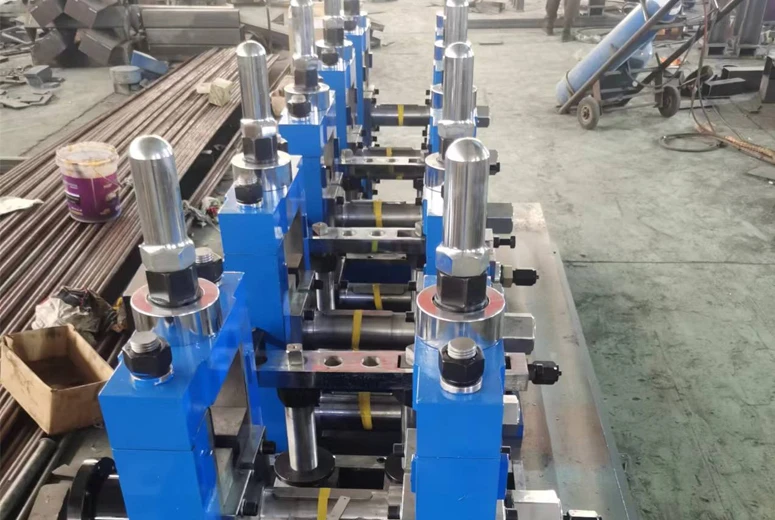a rolling mill
The Art of Rolling Mills Transforming Metal into Masterpieces
Rolling mills have long been a cornerstone of metalworking and manufacturing, serving as vital machinery in the production process of various materials. With a rich history rooted in the industrial revolution, these mills have evolved significantly, embracing technology while retaining their fundamental purpose to transform metal into usable products through the application of pressure and heat.
What is a Rolling Mill?
A rolling mill is a machine or factory that reduces the thickness of metal sheets and strips by passing the metal between a series of rollers. The process is known as rolling, which can be performed at ambient temperatures (cold rolling) or at elevated temperatures (hot rolling). This technique not only reshapes the metal but also refines its microstructure, enhancing its mechanical properties.
Rolling mills can be categorized into two main types flat rolling mills and section rolling mills. Flat rolling mills are utilized for producing sheets, plates, and strips, while section rolling mills are used to produce various shapes, such as beams, angles, and channels.
The Rolling Process
The rolling process typically begins with large metal ingots or billets, which are heated to a pliable temperature. Once the metal is sufficiently heated, it is passed through a set of rollers, which compress the metal and reduce its thickness. The rollers can be adjusted to control the final thickness and surface finish of the metal. The metal may go through several passes between different sets of rollers to achieve the desired dimensions and properties.
One of the remarkable aspects of rolling mills is the ability to produce large quantities of metal with exceptional precision. Advanced rolling mill technologies, such as computer numerical control (CNC) systems and automation, have streamlined this process, allowing for real-time adjustments and monitoring. These innovations have not only increased efficiency but also improved the consistency and quality of the final products.
Applications of Rolling Mills
Rolling mills are critical in various industries, including construction, automotive, aerospace, and manufacturing. They produce materials essential for the structural integrity of buildings, vehicles, and machinery. For instance, rolled steel products are fundamental in the construction of skyscrapers and bridges, providing the necessary strength and durability.
a rolling mill

In the automotive industry, rolling mills create components such as body panels, frames, and chassis. The lightweight and high-strength materials produced through rolling processes contribute to the overall efficiency and safety of vehicles. Meanwhile, the aerospace sector relies on rolled aluminum and titanium sheets for aircraft manufacturing, where weight reduction and structural performance are paramount.
Environmental Considerations
The operation of rolling mills does come with environmental considerations. The processes often consume significant amounts of energy and can emit greenhouse gases. However, the industry is continuously seeking ways to mitigate these impacts. Many rolling mills have adopted energy-efficient technologies and practices, such as recovering waste heat, using renewable energy sources, and recycling water.
Moreover, advancements in materials science are leading to the development of new alloys and compounds that can be processed more sustainably, reducing the overall environmental footprint. As industries face increasing pressure to operate sustainably, rolling mills are evolving to meet these demands while maintaining productivity.
The Future of Rolling Mills
As technology continues to advance, the future of rolling mills looks promising. Innovations in artificial intelligence, machine learning, and robotics are likely to further enhance operational efficiency and product quality. Smart manufacturing systems will enable rolling mills to integrate seamlessly with supply chains, ensuring that production meets real-time demands.
Additionally, the ongoing focus on sustainability will drive further advancements in green technologies and practices within the industry. Rolling mills that can adapt to these changing landscapes will not only survive but thrive in the competitive market.
Conclusion
Rolling mills are more than just machines; they represent the intersection of engineering, technology, and craftsmanship. By transforming raw metal into products that shape our world, they play an indispensable role in modern manufacturing. As the industry evolves, rolling mills will continue to adapt, ensuring they remain relevant in a rapidly changing technological landscape while contributing to a sustainable future. Whether shaping the framework of a building or the body of a car, the art of rolling mills continues to be a pivotal force in metalworking.
-
High Frequency Straight Seam Welded Pipe Production Line-BzZhou Xinghua Machinery Equipment Manufacturing Co., LTD.|Precision Welding, High EfficiencyNewsJul.30,2025
-
High Frequency Straight Seam Welded Pipe Production Line|BzZhou Xinghua|Precision Welding&EfficiencyNewsJul.30,2025
-
High Frequency Straight Seam Welded Pipe Production Line - BzZhou Xinghua|Precision Engineering&EfficiencyNewsJul.30,2025
-
High-Frequency Straight Seam Welded Pipe Production Line-BzZhou Xinghua Machinery Equipment Manufacturing Co., LTD.NewsJul.30,2025
-
High-Frequency Straight Seam Welded Pipe Production Line-BzZhou Xinghua Machinery Equipment Manufacturing Co., LTD.|Precision Manufacturing, High EfficiencyNewsJul.30,2025
-
High Frequency Straight Seam Welded Pipe Production Line-BzZhou Xinghua Machinery Equipment Manufacturing Co., LTD.|Precision Steel Pipe Manufacturing&Industrial EfficiencyNewsJul.29,2025


